
“Barter” marriages are not uncommon. My grandfather’s generation did it in Punjab because it was wise to marry two sisters to two brothers; particularly, if the family was large or wealthy. My parents’ generation did it through the “middle-person” during family negotiations in an effort to bring more relatives abroad.
What is uncommon in our generation is that “bartering” is very upfront. It is included in matrimonial ads along with height, skin complexion, and age.
Raveena Aulakh reports for the Toronto Star that some families abroad are pressured and guilted by relatives in India to figure out a way to bring their children to Canada. Siblings in Canada are accused of not wanting their nieces and nephews to have a good life. The only resort left is to run a matrimonial ad requesting a “barter” for their children or nieces/nephews in prominent Punjabi newspapers.
Aulakh writes about Jaspal Singh, a cab driver in Vancouver, who was guilted into running such an ad by his brother in India.
Finally, Singh agreed to place an ad for his own 21-year-old son and 20-year-old daughter in hopes someone, somewhere would reciprocate with Canadian matches for his niece and nephew in India.
It is not only a long shot, it is also unethical, Singh admits. He says he has told his kids he will not force them to do something they are not ready for and that weddings would take place only after they have met their prospective partners and are ready.
He has paid for the ads to run for four weeks. If things do not fall into place by then, Singh says he has no intention of following up with more ads. “How long can you do it? I will not force them to get married for the sake of it.”
Singh knows it will put a strain on his relationship with his brother, and is already dreading that conversation.
We’ve all sat through it before…or…stood through it, that is.
As Anand Sahib ends, we stand for Ardaas and collectively reflect on the lives and accomplishments of the Gurus and the 18th century martyrs who gave their lives to preserve our Sikh way of life. Somewhere in between this reflection, and wishing for “Sarbat da Bhala“, we take a bizarre detour in to the “ins and outs” of our community.” Yes…I am referring to the lengthy list of births, birthdays, graduations, anniversaries and other milestones we find in the middle of our Ardaas.
I’m not sure when this practice started; where a member of the sangat would make an offering to the Gurdwara so an “Ardaas” can be done on their behalf. Birthdays are most common week to week, but I have heard more creative ones – celebrating a new job, new car, first mother’s day, wishing someone well on an upcoming exam, or safe travels for someone’s trip to India. Some even taken advantage of this process, by doing an “Ardaas” on behalf of their business week after week – essentially advertising their local store, while they have the entire community’s ear. I’ve raised this issue to the committee that perhaps there needs to be a better way to handle these “community announcements” rather than during Ardaas…I mean, seconds after we recount the martyrs who were cut limb by limb and scalped, we collectively thank Waheguru for Tinku’s new Benz? It just doesn’t seem right.
As the economic down-turn leads to increased joblessness, many countries are paying immigrant workers to return to their home countries. Japan, Spain, and the Cezech Republic are paying immigrant workers to return home with the stipulation that they not migrate back to the aforementioned countries for an x-amount of years. Thus, freeing up jobs for citizens and creating a bandage solution to crime and homelessness-as if these issues are only an “immigrant problem”.
BBC’s “World Have Your Say” reported this week that Czech Republic is offering just under $1,000 per immigrant; the Spanish government has offered six months of unemployment benefits, around $18500; and Japan is offering $3,888 per Latino worker plus an additional $2,000 per dependent.
According to The Wall Street Journal, large numbers of immigrants are actually taking up the offers; however, some are choosing to bypass the pay-off. Many find that the money they borrowed to arrive in these countries far exceeds the amount being offered. It would be very difficult for them to return home and find jobs that would help them repay their loans-the very reason they immigrated abroad. Jobs at home don’t provide a reliable and sustainable source of income.
Ultimately, these “pay-offs” frame immigrants as the root cause of problems in foreign countries. Not only do immigrants take-away jobs from local citizens; in a declining economy their joblessness leads to crimes and homelessness. Once again, the scapegoat is immigrants. The Economist reports that paying off immigrants to return to their home countries is a temporary solution to deeper problems.
What do you think?
 Things are heating up as Sikh transit workers organize against the MTA’s requirement that Sikh workers wear an MTA logo on their turbans. The rationale? The MTA’s position is that this policy is necessary for customers to identify their employees. However, neither the NY City Council, nor the U.S. Department of Justice, is buying this baloney. The 27 of the City Council’s 51 members recently voted to sign onto a letter to the MTA President, opposing the policy, and the Department of Justice has revived an employment discrimination case against the MTA.
Things are heating up as Sikh transit workers organize against the MTA’s requirement that Sikh workers wear an MTA logo on their turbans. The rationale? The MTA’s position is that this policy is necessary for customers to identify their employees. However, neither the NY City Council, nor the U.S. Department of Justice, is buying this baloney. The 27 of the City Council’s 51 members recently voted to sign onto a letter to the MTA President, opposing the policy, and the Department of Justice has revived an employment discrimination case against the MTA.
There are, of course, many ways that customers can identify MTA workers, from the badges they may wear, to a uniform vest, to a standard outfit. So why attempt to brand the turban, specifically? This policy shift, along with previous failed attempts, is indicative of the MTA’s general hostility to religious inclusion and work staff diversity.
Ravi Singh Bhalla was elected to the City Council in Hoboken, New Jersey this past week! A city that is less than 1% Asian and predominately white, Hobokens elected Bhalla with 5,810 votes. Bhalla had the highest number of votes amongst the 6 candidates competing for the 3 council seats.
In an e-mail out to supporters, Ravi’s brother, Amardeep Singh, described the bigotry they received during this campaign. He writes:
“… elections are not always for the faint of heart … we were cursed at constantly, literature was ripped out of our hands and stomped on, I was told by someone “I love killing Arabs”, and I was asked whether I “had a green card.”
Despite these attacks, the residents of Hoboken voted for Bhalla because he was a committed candidate who focused on the issues. Bhalla says, “It’s very humbling … it shows that people were focused on what a candidate brought to the table.”
 This past weekend Wal-Mart opened its first* Indian-based store in Amritsar, spreading its global brand to one of the fastest-growing markets in the world. As part of a larger strategy to develop a presence in India, this is the first of fifteen new stores that will open over the next few years. [source]
This past weekend Wal-Mart opened its first* Indian-based store in Amritsar, spreading its global brand to one of the fastest-growing markets in the world. As part of a larger strategy to develop a presence in India, this is the first of fifteen new stores that will open over the next few years. [source]
However, instead of targetting low-income consumers and discount shoppers, Wal-Mart India’s business model focuses on wholesales to small shop stand owners. This decision seems largely based in regional market dynamics. Wal-Mart does not think it can crowd out a market share against small dhabas and the like, and instead opts for wholesaling:
Mr. Singh and the more than 10 million other tiny retailers in India are Wal-Mart’s greatest challenge and greatest opportunity. If it can win them over, they are likely to become its biggest customers. Anger them and they could use their political power to block expansion.
Wal-Mart entered with nary a whisper or protest, despite years of vocal opposition to big-box stores in the past. The WSJ cites the slowing economy, but I wonder to what extent choosing Amritsar, as opposed to metro Mumbai or Delhi, indicates Wal-Mart’s desire to build a presence in transitional, recessionary regional economies.
Over at Huffington Post, a lovely reflection on “The Cancer of Religious Narcissism” appeared recently. It’s point of orientation was the violence amongst Austrian Sikhs. The focus however, was on how religious narcissism is often the cause of such religious violence- when the slightest doctrinal difference leads to bloodshed… not only amongst Sikhs, but also amongst other faith communities. For example, in 2008, Greek and Armenian priests and worshippers exchanged blows at one of Christianity’s holiest shrines.
Catholics all over Europe have killed Protestants by the thousands and slaughtered their children, and Protestants have done the same. The Crusaders mounted genocidal attacks on Arabs and Jews. Modern efforts to win over moderates in Afghanistan are consistently sabotaged by fundamentalist military chaplains who tell our troops they’re fighting Satan and should be murdering anyone they can’t convert.
Precisely what the Imams are telling the Taliban. For homicidal proclivities seem endemic to most of the world’s major religions. Hindus and Muslims slaughter each other, as do Israelis and Palestinians, Sunnis and Shiites. And the Bible is filled with genocide, supposedly ordered by God. Why is this so?
The author’s’ answer: most organized religions are based on systems of belief. And we all want to believe our own tales are fact.
 As talking heads buzzed with news of President Obama’s nomination of Sonia Sotomayor to the Supreme Court, there has also been a flurry of commentary. Is her selection tokenizing? Is it triumphant? Is she smart enough? Is she nice enough? I don’t think it’s particularly useful to parse the commentary on Judge Sotomayor specifically — a lot of the back and forth parallels and reproduces the tropes that come out in any discussion addressing privilege and remediation.
As talking heads buzzed with news of President Obama’s nomination of Sonia Sotomayor to the Supreme Court, there has also been a flurry of commentary. Is her selection tokenizing? Is it triumphant? Is she smart enough? Is she nice enough? I don’t think it’s particularly useful to parse the commentary on Judge Sotomayor specifically — a lot of the back and forth parallels and reproduces the tropes that come out in any discussion addressing privilege and remediation.
The same day, a relatively lengthy commentary previewed on NPR’s morning edition. It argued that while Obama’s nomination was a triumph (if successful, Sotomayor will be the first woman of color and first Latina on the Court), the President should examine other forms of diversity on the bench. Specifically, he should appoint an LGBT Justice, next.
The recent caste-based violence in a Vienna and Punjab has shown us the horrible consequences of casteism. Sathnam Sanghera recently did a short report, “Caste Matters”, which investigates the possibility of legally outlawing caste-based discrimination in the UK.
Often we think caste-based discrimination is a 1st generation issue that becomes diluted in the Diaspora. However, CasteWatchUK has anecdotal evidence to show otherwise. They have lobbied to include caste-based discrimination as part of a stream-lined single equality act that would go into effect in 2010. If the group provided research evidence that caste-based discrimination existed in areas managed by the government, such as jobs and social services, then caste would be added to the equality act along with race, religion, and sexual orientation. However, this evidence has yet to be provided, aside from anecdotal examples from the work-place. The lack of aggregate evidence is only due to a lack of investigative research, as the anecdotal cases prove that it is indeed occurring.
You can listen the BBC Asian Network Report here.
Let’s us know what you think. Do you think caste-based discrimination should be included in equality acts in the Diaspora, such as the UK, USA, and Canada? If so, why?
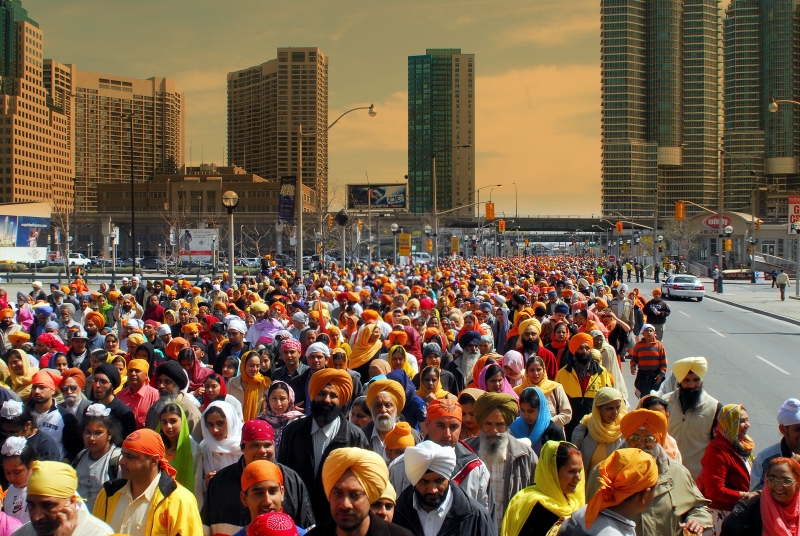 Years ago, I attended a Sikh retreat far from home – outside of the United States and outside of my “normal crowd.” It was interesting to experience Sikh life in a different country…and I think Bono had it right when he said, “We are one, but we’re not the same.”
Years ago, I attended a Sikh retreat far from home – outside of the United States and outside of my “normal crowd.” It was interesting to experience Sikh life in a different country…and I think Bono had it right when he said, “We are one, but we’re not the same.”
The first morning we all woke up at Amrit Vela and joined in Nit-Nem and Shabad Keertan. Everybody was in to it and nobody seemed distracted. It was one of those powerful “Sangat” experiences where you lose yourself and become part of the whole. I loved it! I was so energized after that Deevan and was excited for all the weekend’s activities to come…then came breakfast.
(more…)
This past weekend, as I was talking to a Punjabi Sikh woman who came to the United States about 13-14 years ago, I heard how agency and perseverance define the experiences of immigrant women in the United States. She told me about the great new apartment she just got for her family and how the laundry is free. A new apartment building with free laundry, that is absolutely awesome! Her smile, confidence, and enthusiasm were strongly lined with struggle and hard work; although she never directly said it. Her hard work and perseverance resounded clearly and loudly as it lay nestled in her comment about how her children had seen a lot of struggle in their lives. This statement meant that they had witnessed her struggle to provide the basic necessities in life, which means not always having access to the privileges other children gain more easily. I sensed her confidence in her and her family’s work ethic, but also her own guilt of not being able to provide more.
This month, New America Media (NAM) released the results of a historic poll on woman immigrants to America. Often the experiences of women immigrants are not fore grounded in immigration research. They and their children are general viewed as the “dependents” of the sojourner husband/father. Their struggle, as the one mentioned above, are rarely brought to the center of the immigrant narrative.
 At the Langar Hall, we’ve covered a number of Sikh candidates’ campaigns for local government office. I just wanted to include a brief update about Ravi Bhalla, who looks poised to become one of Hoboken’s first Sikh city councilmembers as he enters a run-off election next month:
At the Langar Hall, we’ve covered a number of Sikh candidates’ campaigns for local government office. I just wanted to include a brief update about Ravi Bhalla, who looks poised to become one of Hoboken’s first Sikh city councilmembers as he enters a run-off election next month:
While it is clear that Peter Cammarano and Dawn Zimmer will vie for the Hoboken mayoralty on June 9, the provisional ballots may still change the neck-and-neck race to see which of the last three of six council-at-large candidates get into the runoff on that date. […]
As of Tuesday night, it looked like the top six will be as follows:
[1.] Carol Marsh 3,719
[2.] Ravi Bhalla 3,698
[3.] Dave Mello 3,361 [link]
When we last covered this story, Ravi was running as an independent for office. Since then, he joined a “reform” slate and has been campaigning extensively. His success comes as a surprise to some, who don’t understand how a practicing Sikh could get so far…
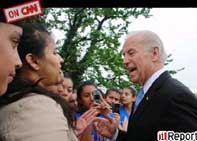
Gurbakhash Kaur Questioning Vice President Joe Biden
One of the major issues affecting the Sikh community is increasing civic engagement in the United States. We often focus on getting more Sikhs to vote and lobby our politicians about the issues affecting our community. This lobbying general pertains to writing letters and signing petitions that ask our community members to move beyond taking pictures with politicians at fundraising events or giving them awards at local melas. This past week, a young Sikh woman, Gurbakhash Kaur, highlighted what it means for a Sikh to be civically engaged. She questioned Vice President Biden “about two Sikhs in the United States Army who were told to cut their hair in order to serve” and Governor Jon Corzine about rising health education costs, while her Sikh peers stood by her side. These handshaking events were not a forum set-up for accountability, but more as photo-ops for the politicians. However, Gurbakhash Kaur was determined to make hand-shaking an opportunity to hold our elected officials accountable to their Sikh constituency.
As a resident of Lodi, New Jersey, she got face-time with Vice President Biden during his visit for a new construction project to widen Main Street and US Route 46. During her questioning, World Sikh News reports that:
Vice President Biden interrupted Kaur to tell her a member of his staff is a Sikh and did not allow her to finish her question. Afterwards, Kaur said, “I want the story to get coverage, as hardly anyone pays attention to our issues . . . we need a lot more legal support and begging and pleading to get our issues addressed.”
Ultimately, Gurbakhash Kaur’s actions are inspiring because she highlights an example of Sikh’s standing up for our rights through self-empowerment. More importantly, she acted through self-organizing rather than taking part in an event organized by other groups to mobilize the Sikh community.
Kuddos to Gurbakhash Kaur for demanding accountability from our elected officials!
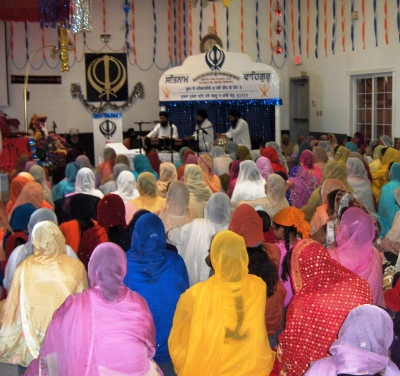 Phulkari’s post a few weeks back got me thinking about Gurdwaras – their origin and the role they play in Sikh society today. History tells us that Guru Nanak Patshah created Dharmshalas in Kartarpur where Sikhs would rise early and meet for Keertan, Veechar, reflection, and Guru-ka-Langar. It was a central element to the ideal society that Kartarpur would become.
Phulkari’s post a few weeks back got me thinking about Gurdwaras – their origin and the role they play in Sikh society today. History tells us that Guru Nanak Patshah created Dharmshalas in Kartarpur where Sikhs would rise early and meet for Keertan, Veechar, reflection, and Guru-ka-Langar. It was a central element to the ideal society that Kartarpur would become.
Over a century ago, Sikhs first arrived in North America – working at lumber mills, railroads, and as migrant laborers. They settled their families and chose to establish Gurdwaras (as early as 1908 in West Vancouver, BC and 1912 in Stockton, CA) to preserve both their spiritual and cultural roots in the land far from their history.
Now with hundreds of thousands of Sikhs in North America and the needs of our communities growing, the Gurdwara has expanded the services it offers far beyond its humble beginnings. Many Gurdwaras have Khalsa schools and libraries. Others plan for fitness centers, basketball courts, and healthcare clinics. One of the local Gurdwaras here hosts an annual Panjabi cultural show and mela, with weekly Giddha and Bhangra practices held at the Gurdwara facility itself. The North American Gurdwara has become not only a spiritual center, but also a community center, serving all the needs of the Sikh and Panjabi population.
On the one hand, I like having a Gurdwara as the center for our community’s activity. Although not all people have an initial interest in Sikhi, all these other events and programs at least keep people coming. And even a short “ritualistic” trip to the Gurdwara could develop in to something more. On the other hand, I can’t help but wonder…are we asking too much from our Gurdwaras?
With such different and competing interests, leaders fight for position so they can make their agenda the focus, and control Gurdwara resources accordingly. This drives much of the political drama and power struggles that surround our Gurdwaras today. As a result, many programs (such as Khalsa schools) end up mismanaged, poorly resourced, and inefficient.
Secondly, with all the programs our Gurdwaras offer, I question – are we taking away from the primary purpose of the Gurdwara…learning Gurmat (the Guru’s way)? How well do our Gurdwaras focus on Simran and Veechar? How well do our Gurdwaras connect the youth with the Guru’s message? What about services for non-Panjabi speakers or introducing non-Sikhs to our faith? What about programs emphasizing Sikh culture – like Gatka or Gurmat Sangeet? Are our Gurdwaras really institutions for learning? If the answer is less than perfect, shouldn’t we re-prioritize and change the focus of our Gurdwaras?
Many Gurdwaras serve small communities in rural areas where limited resources force the Gurdwara to serve multiple purposes. However, in larger communities, where resources are plenty – should we consider separating out our organizations? Maybe create separate Punjabi societies, Khalsa schools, clinics, and even Sikh community centers that focuses on outreach, youth counseling, and seva projects?
Perhaps under separate structures and management, these organizations will be able to thrive and meet their goals more efficiently with less resistance. And with our community’s growing needs, why not grow our presence with more diverse organizations?
Thoughts?
Kes is an important part of the Sikh identity but it also carries social, cultural, and political meaning for more than just Sikhs. Recently, a film student from NYU explored this less explored cross-cultural perspective by speaking with 3 individuals from various backgrounds in an interesting (and short-18 minute) documentary.
The film engages with a Sikh (Sonny Singh from the Sikh Coalition’s New York office), an African-American woman, and a woman with trichotillomania – a disorder that causes the sufferer to compulsively pull out hair. We often consider kes in the context of religion, beauty, and identity; but rarely do we do so in a cross-cultural perspective (unless you grew up in a culturally diverse community). The film is thoughtful and thought-provoking, so I’ll let it speak for itself. It includes footage from the recent Sikh Day parade in New York City, as well as a pagh tying competition in Richmond Hill.
[hat tip: sonny]
Hair… As one of the most important aspects of how others see us, how has our hair become interwoven with issues of race, religion, beauty, and identity?
Sikhism mandates that the hair is never cut. We explore the rationale behind this and the discrimination that Sikhs face today in a post 9-11 world.
Many women of African descent grow up to think negatively about their natural hair. So begins the burdensome, expensive, and often painful process of weaves and chemical straightening, as a however subconscious attempt to achieve a homogenized concept of beauty. We speak to a woman who takes pride in her natural hair and is committed to show others how truly beautiful “nappy” hair can be.
Sometimes what we do with our hair is not a choice. Trichotillomania is a disorder that causes the sufferer to compulsively pull out hair. We will meet a long-term lash/brow puller who describes how people have reacted to her disorder and how these experiences have shaped her. [link]
The crisis of Sikh identity was once described to me in very simple terms; most Sikh males no longer want to look like Sardars and most Sikh girls don’t want to marry Sardars. In fact, I distinctly remember several Sikh guys that I went to school cutting their hair for the simple reason of “getting girls”.
Over the past few years, we’ve seen efforts on many fronts to confront this trend, including beauty pageants (Mr. Singh International), Sikh models (Sunny Singh Caberwal of Kenneth Cole and now GQ fame). Now, in a twist on the standard Sikh dharmak or religious song, Taranmpreet has released a track called “Teri Meri Bas: Sat Sri Akal”.

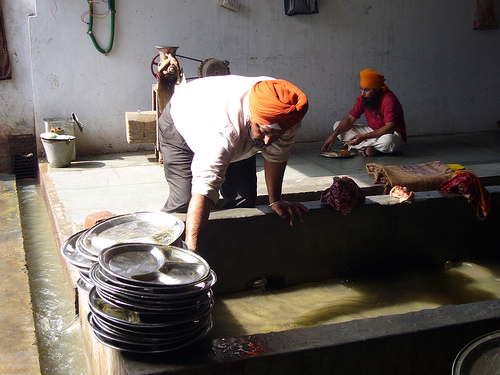 On TLH we have discussed Green Gurdwaras. Part of this green initiative is to use steel plates (i.e. thaals) and cutlery instead of the common paperware. A couple of weeks ago at a local Gurdwara langar, I saw steel plates being used that had been stored away in cupboards for years. Every week disposable cups, plates, spoons and forks were used by the sangat. Somehow in a community with a growing immigrant Punjabi population disposable means modernity. I remember watching sangat members come stand in the standard langar line and show surprise as they reached the front and saw large piles of steel plates. The reactions were amazing. We had aunties with twitched noses who continued to scrub the steel plates although they had been cleaned and washed the night before and showed no signs of being dirty. Uncles made comments like, “hun taan aapaan Punjab ton nikal gaye, a hun desi kamm ithhe vi shuru kar taa”. Others just smirked and laughed.
On TLH we have discussed Green Gurdwaras. Part of this green initiative is to use steel plates (i.e. thaals) and cutlery instead of the common paperware. A couple of weeks ago at a local Gurdwara langar, I saw steel plates being used that had been stored away in cupboards for years. Every week disposable cups, plates, spoons and forks were used by the sangat. Somehow in a community with a growing immigrant Punjabi population disposable means modernity. I remember watching sangat members come stand in the standard langar line and show surprise as they reached the front and saw large piles of steel plates. The reactions were amazing. We had aunties with twitched noses who continued to scrub the steel plates although they had been cleaned and washed the night before and showed no signs of being dirty. Uncles made comments like, “hun taan aapaan Punjab ton nikal gaye, a hun desi kamm ithhe vi shuru kar taa”. Others just smirked and laughed.
There were also positive reactions where aunties and uncles supported the langar sevadars for reintroducing steel plates. These sangat members felt that these plates helped reduce waste while encouraging the action of seva. Interestingly, they said more seva is done by cleaning jutha plates than by just throwing them away. By cleaning jutha plates, it reinforced a sense of humility of cleaning other peoples’ waste. In addition, some people showed a lot of humility by refusing to allow the sevadars to take and wash their plates. For example, an elderly woman, who had difficulty walking, slowly took her plate inside the kitchen and washed it herself. Lastly, a number of sevadars, aside from the family doing langar seva that week, decided to help clean plates. An assembly line of cleaners and dryers was set-up. Some spoke and others just quietly felt the spirit of doing seva together. Ultimately, by reintroducing steel plates the spirit of seva was rekindled in a new way.
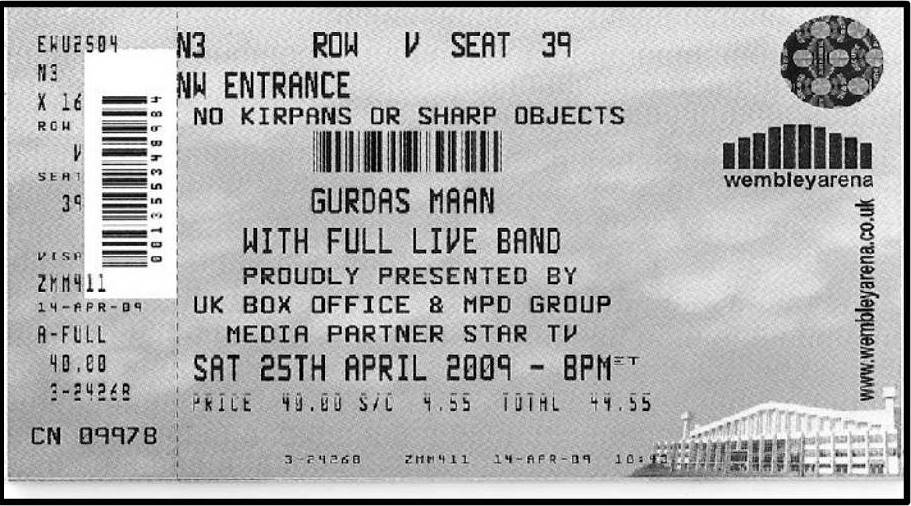
Vaisakhi in the diaspora usually brings two things to those living in cities with large Sikh communities: Nagar Kirtans and Vaisakhi concerts. Unfortunately, if you were an Amritdhari Sikh in London this year and you wanted to partake in both, you would have been out of luck. Tickets for the recent Gurdas Maan concert held at Wembley Arena had a unique warning printed on them, “NO KIRPANS OR SHARP OBJECTS”.
I won’t dwell too much on the irony of banning kirpans at a Vaisakhi concert, which usually start with the requisite dharmak songs, like Gurdas Maan’s tribute to Guru Gobind Singh and his contributions to Sikhi.
What I wonder is exactly what the organizers must have been thinking in doing this. I suspect the banning of kirpans probably falls under generic security rules banning knives and other weapons. In fact the terms and conditions on their website state that the “possession of any article, which is or may be used as a weapon or missile” is strictly prohibited. Pretty standard fare at all large venues.
According to the Sikh Times, Sikh police officers are coming together to help address discrimination within the workforce in addition to addressing community relations between Sikhs and the British police.
The Association, which is to launch next Wednesday, lists its goals as follows:
The aims and objectives of the BPSA are;
- To establish a national forum for Sikh members of the British police services
- To assist the British police services in developing strategies to recruit, retain, and progress Sikh members of the service hence increasing Sikh representation in the police service at all levels
- To provide a religious, cultural and social forum for members of the BSPA through celebration of dates and festivals on the Sikh calendar.
- To promote an understanding of the Sikh Faith and the Sikh values of democracy, equality and justice within the police services
- To provide support and advice to Sikh members of the police service.
- To promote social cohesion and integration.
It seems like Canada is showcasing one socially conscious Sikh rapper after another. TLH has covered “Humble The Poet” and now here is “Sikh Knowledge” from Montreal. Sikh Knowledge raps with Lotus on issues effecting the 2nd generation and marginalized peoples.
Kanwar Anit Singh Saini, a.k.a. Sikh Knowledge, is the son of Punjabi Sikh immigrants. He works in the field of speech pathology where he contributes his musical knowledge to the health sciences field.
Check out his songs below and let us know what you think!
Disclaimer: There are graphic descriptions and swear words in the videos below.
